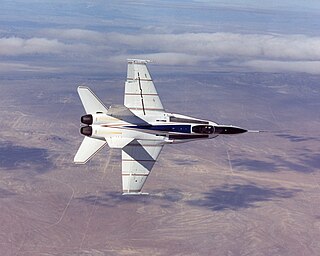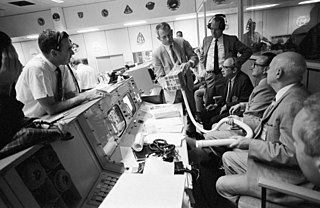
Aeroelasticity is the branch of physics and engineering studying the interactions between the inertial, elastic, and aerodynamic forces occurring while an elastic body is exposed to a fluid flow. The study of aeroelasticity may be broadly classified into two fields: static aeroelasticity dealing with the static or steady state response of an elastic body to a fluid flow, and dynamic aeroelasticity dealing with the body's dynamic response.

The Grumman X-29 is an American experimental aircraft that tested a forward-swept wing, canard control surfaces, and other novel aircraft technologies. Funded by NASA, the United States Air Force and DARPA, the X-29 was developed by Grumman, and the two built were flown by NASA and the United States Air Force. The aerodynamic instability of the X-29's airframe required the use of computerized fly-by-wire control. Composite materials were used to control the aeroelastic divergent twisting experienced by forward-swept wings, and to reduce weight. The aircraft first flew in 1984, and two X-29s were flight tested through 1991.

The American Institute of Aeronautics and Astronautics (AIAA) is a professional society for the field of aerospace engineering. The AIAA is the U.S. representative on the International Astronautical Federation and the International Council of the Aeronautical Sciences. In 2015, it had more than 30,000 members among aerospace professionals worldwide.

The BMW H2R is a racecar adapted to run on liquid hydrogen fuel. It was conceived and developed in 10 months under the direction of Dr. Raymond Freymann.
A turbosteamer is a BMW combined cycle engine using a waste heat recovery unit. Waste heat energy from the internal combustion engine is used to generate steam for a steam engine which creates supplemental power for the vehicle. The turbosteamer device is affixed to the exhaust and cooling system. It salvages the heat wasted in the exhaust and radiator and uses a steam piston or turbine to relay that power to the crankshaft. The steam circuit produces 14 hp (10 kW) and 15 ft⋅lbf (20 N⋅m) of torque at peak, yielding an estimated 15% gain in fuel efficiency. Unlike gasoline-electric hybrids, these gains increase at higher, steadier speeds.
US Air Force Flight Dynamics Laboratory is located at Wright-Patterson Air Force Base and is part of the Air Force Wright Laboratory. The Laboratory was eventually merged into the Air Force Research Laboratory in 1997.

The X-53 Active Aeroelastic Wing (AAW) development program is a completed American research project that was undertaken jointly by the Air Force Research Laboratory (AFRL), Boeing Phantom Works and NASA's Dryden Flight Research Center, where the technology was flight tested on a modified McDonnell Douglas F/A-18 Hornet. Active Aeroelastic Wing Technology is a technology that integrates wing aerodynamics, controls, and structure to harness and control wing aeroelastic twist at high speeds and dynamic pressures. By using multiple leading and trailing edge controls like "aerodynamic tabs", subtle amounts of aeroelastic twist can be controlled to provide large amounts of wing control power, while minimizing maneuver air loads at high wing strain conditions or aerodynamic drag at low wing strain conditions. This program was the first full-scale proof of AAW technology.
Jan Roskam was a Dutch-born American aircraft designer. He was the Deane E. Ackers Distinguished Professor of Aerospace Engineering at the University of Kansas. He was also the author of eleven books on airplane design and flight dynamics and over 160 papers on the topics of aircraft aerodynamics, performance, design and flight controls. He founded the company DARcorporation with Willem Anemaat.
Jerome Pearson was an American engineer and space scientist best known for his work on space elevators, including a lunar space elevator. He was president of STAR, Inc., and has developed aircraft and spacecraft technology for the United States Air Force, DARPA, and NASA. He held several patents and was the author of nearly 100 publications in aircraft, spacecraft, electrodynamic tethers, SETI, and global climate control.

Aerospace engineering is the primary field of engineering concerned with the development of aircraft and spacecraft. It has two major and overlapping branches: aeronautical engineering and astronautical engineering. Avionics engineering is similar, but deals with the electronics side of aerospace engineering.
Boris Laschka is a German fluid dynamics scientist and aeronautical engineer known for his work in unsteady aerodynamics, in applied aerodynamics, in aeroelasticity, and by his participation in the development of several experimental, civil, and military airplanes, e.g. VTOL VJ 101, Airbus A300 and A310, CN 235 and N 250 (Indonesia) and Tornado aircraft.
Charbel Farhat is the Vivian Church Hoff Professor of Aircraft Structures in the School of Engineering at Stanford University, where from 2008 to 2023, he chaired the Department of Aeronautics and Astronautics. From 2022 to 2023, he chaired this department as the inaugural James and Anna Marie Spilker Chair of Aeronautics and Astronautics. He is also Professor in the Institute for Computational and Mathematical Engineering. From 2014 to 2024, he directed at Stanford University the Stanford-King Abdulaziz City for Science and Technology Center of Excellence for Aeronautics and Astronautics; from 2017 to 2023, he served on the Space Technology Industry-Government-University Roundtable; from 2015 to 2019, he served on the United States Air Force Scientific Advisory Board (SAB); from 2008 to 2018, he served on the United States Bureau of Industry and Security's Emerging Technology and Research Advisory Committee (ETRAC) at the United States Department of Commerce; and from 2007 to 2018, he served as the Director of the Army High Performance Computing Research Center at Stanford University. He was designated by the US Navy recruiters as a Primary Key-Influencer and flew with the Blue Angels during Fleet Week 2014.
Holt Ashley was an American aeronautical engineer notable for his seminal research on aeroelasticity.

Peretz P. Friedmann is an American aerospace engineer and an academic. He is the François-Xavier Bagnoud Professor Emeritus of Aerospace Engineering at the University of Michigan, Ann Arbor.

Nils Otto Myklestad was an American mechanical engineer and engineering professor. An authority on mechanical vibration, he was employed by a number of important US engineering firms and served on the faculty of several major engineering universities. Myklestad made significant contributions to both engineering practice and engineering education, publishing a number of widely influential technical journal papers and textbooks. He also was granted five US patents during his career.
The service-oriented computing environment (SORCER) is a distributed computing platform implemented in Java. It allows writing network-programs that operate on wrapped applications (services) to spread across the network. SORCER is often utilized in scenarios similar to those where grids are used in order to run parallel tasks.
ACTRAN is a finite element-based computer aided engineering software modeling the acoustic behavior of mechanical systems and parts. Actran is being developed by Free Field Technologies, a Belgian software company founded in 1998 by Jean-Pierre Coyette and Jean-Louis Migeot. Free Field Technologies is a wholly owned subsidiary of the MSC Software Corporation since 2011. Free Field Technologies and MSC Software are part of Hexagon AB since 2017.
Guru Guruswamy is an American engineer working as principal scientist at Ames Research Center since 1988. He pioneered research in the area of computational aeroelasticity that involves Unsteady Aerodynamics, Finite Element Methods, Computational Fluid Dynamics, Parallel Computing and Problem-Solving Environment. His innovative research was utilized in the first commercial 3-D computational aeroelasticity software developed by a major aerospace industry. The aeroelasticity legend Holt Ashley extensively referred to Guruswamy's research in his classical review paper. In 1988 he demonstrated the unique use of Transonic Small Perturbation based CFD for designing active controls to increase the safety of aircraft. It was followed by a break through development of Euler flow equations based Computational Aeroelasticy. It was cited by another Aeroelasticity legend John Dugundji of MIT as an important milestone in Aeroelasticity. A google search shows about 150 researchers took advantage Guruswamy's work based on the Euler equations for follow-up developments.

Carlos E. S. Cesnik is a Brazilian-American aerospace engineer, academic, and author. He is the Clarence L. (Kelly) Johnson Collegiate Professor of Aerospace Engineering and the founding director of the Active Aeroelasticity and Structures Research Laboratory at the University of Michigan. He also directs the Airbus-Michigan Center for Aero-Servo-Elasticity of Very Flexible Aircraft (CASE-VFA).

Joaquim R. R. A. Martins is an aerospace engineer, academic, and author. He is the Pauline M. Sherman Collegiate Professor in the Department of Aerospace Engineering at the University of Michigan, where he directs the Multidisciplinary Design Optimization Laboratory. He also has a courtesy appointment in the Department of Naval Architecture and Marine Engineering.









